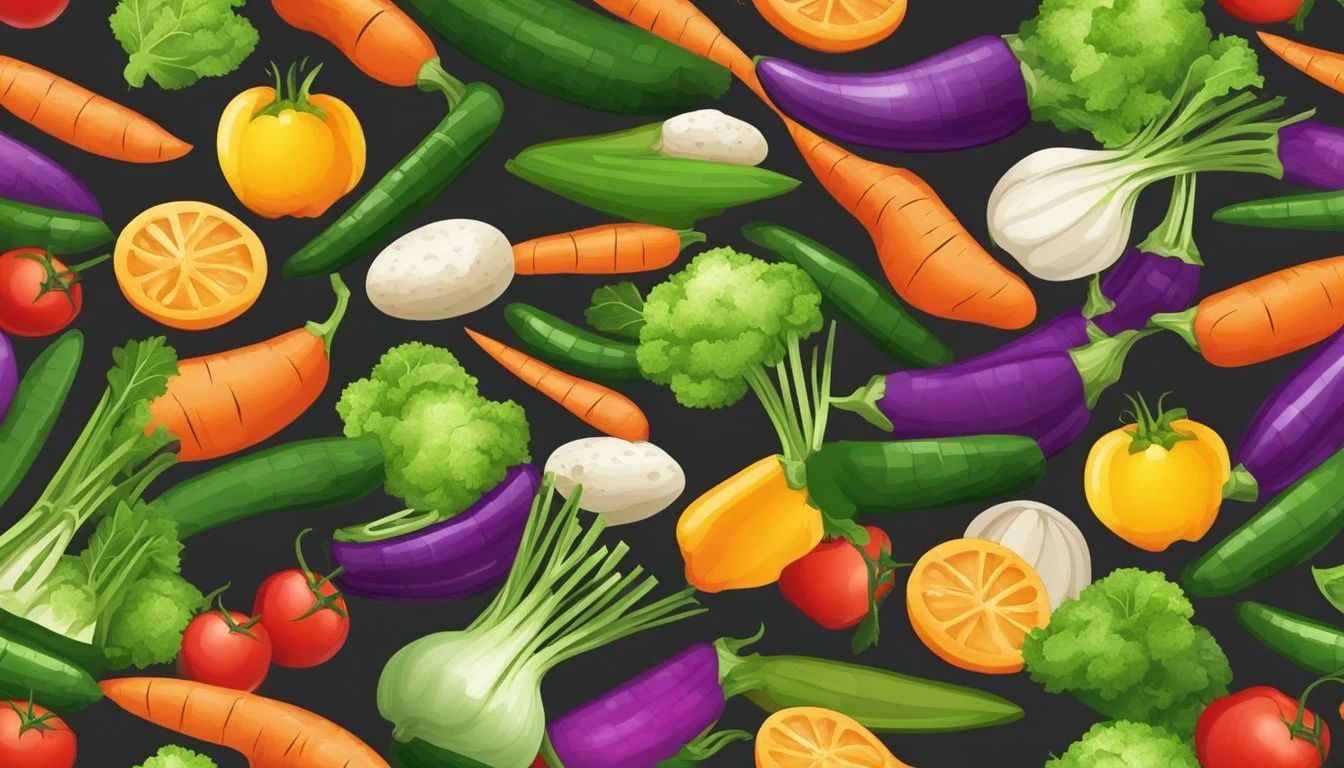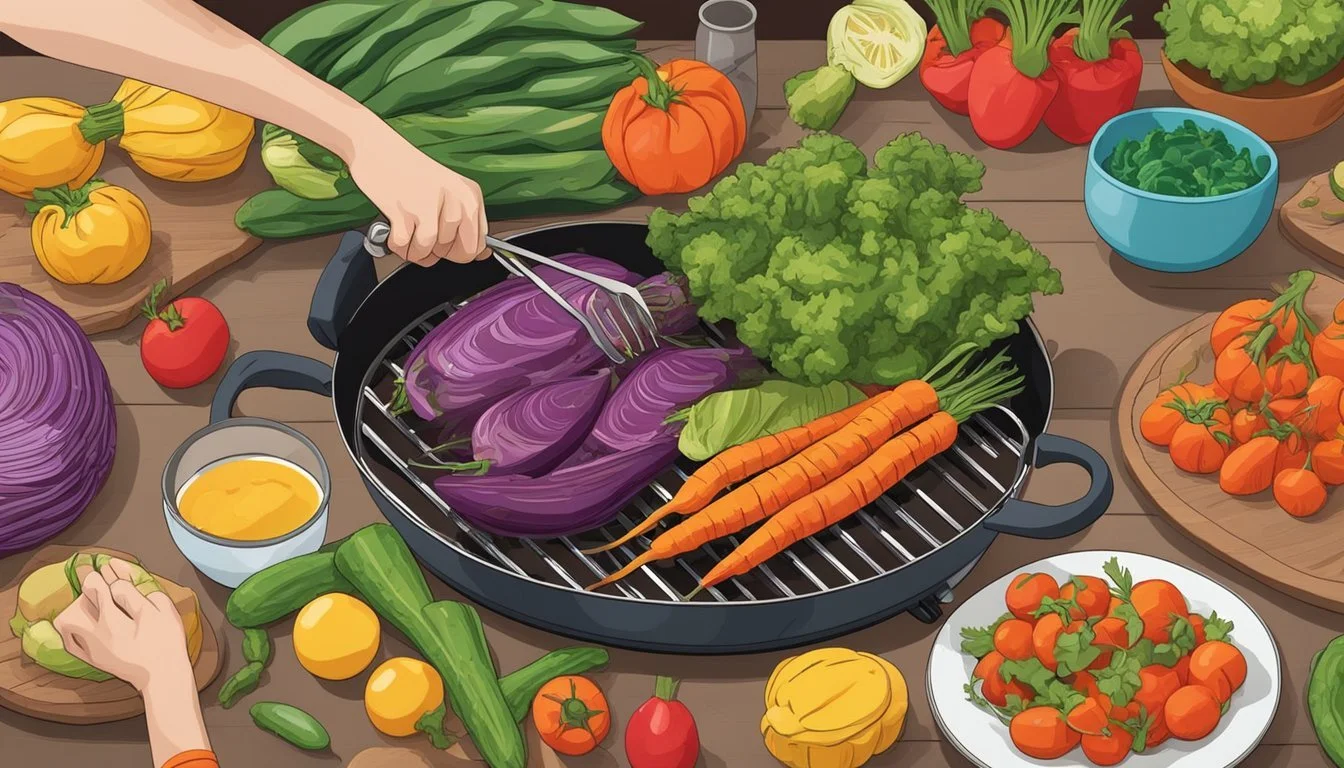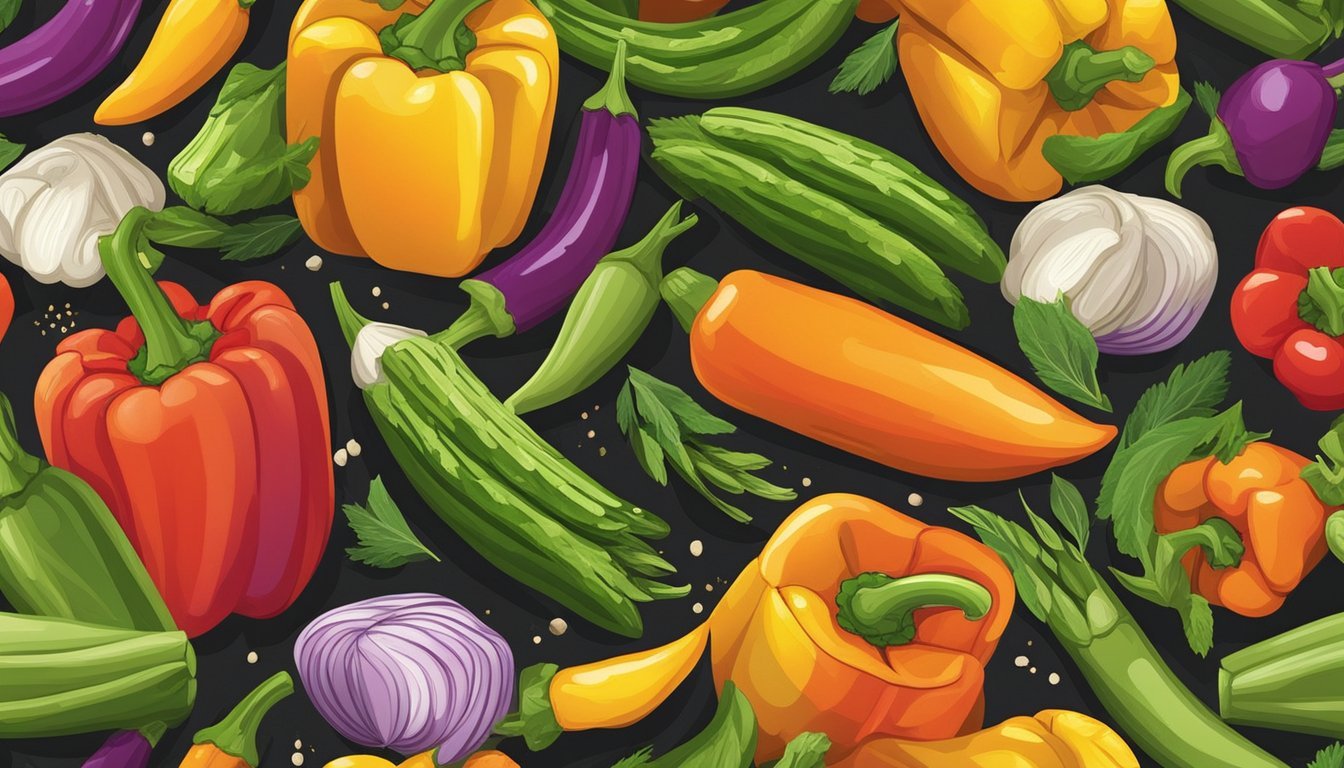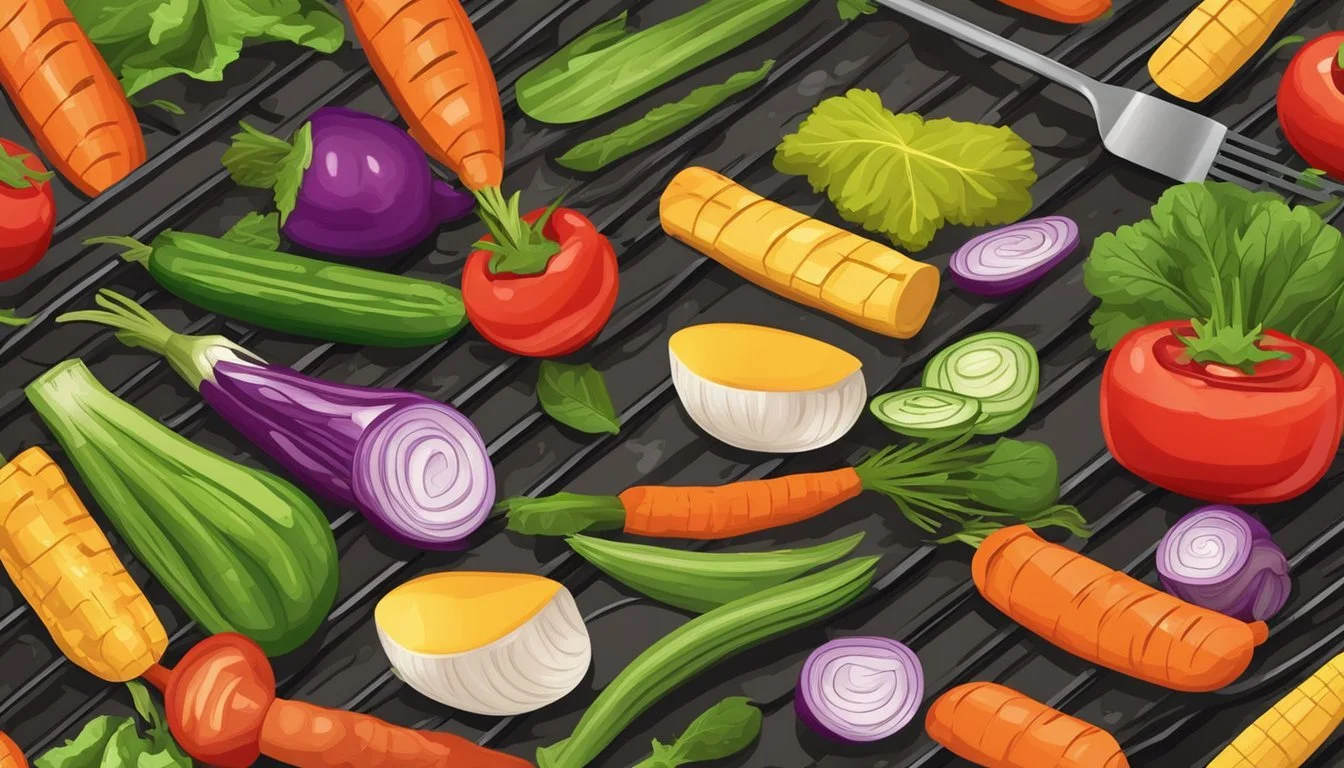Grilling Vegetables for Easter
A Healthy Addition to Your Spring Feast
Grilling vegetables for Easter is an excellent way to incorporate healthy, nutritious options into a festive meal. As families gather to celebrate, offering a platter of grilled vegetables brings both a visual appeal with vibrant colors and a contribution to a well-balanced feast. The act of grilling enhances the natural flavors of vegetables, creating a delightful char and smokiness that can complement any main dish. It's a method that not only excites the taste buds but also retains most of the vegetables' nutritional value, making it a win-win for health-conscious individuals and flavor aficionados alike.
Vegetables are a cornerstone of a nutritious diet, and grilling them is a simple way to boost their innate appeal. This method requires minimal preparation and garnishing, often needing only a light brush of olive oil and a sprinkle of herbs to elevate their taste. The high heat from grilling caramelizes the natural sugars within vegetables, giving them a sweet, robust profile that can stand up to the traditional flavors of Easter meals. From asparagus (What wine goes well with asparagus?) and bell peppers (What wine goes well with bell peppers?) to zucchini (What wine goes well with zucchini?) and squash, a diverse selection can cater to all palates and dietary needs, making grilled vegetables a versatile option.
The tradition of Easter meals typically features rich, hearty dishes, but incorporating grilled vegetables can introduce a balance, satisfying the craving for something lighter without compromising on taste. As a healthy addition to Easter spreads, their inclusion goes beyond mere nutrition; they can transform the dining experience, adding layers of texture and taste that can enhance the overall enjoyment of the holiday meal. For those looking to maintain a healthy eating strategy during festive occasions, grilled vegetables are a straightforward and delicious solution.
Selecting Vegetables
When planning an Easter meal, incorporating a variety of grilled vegetables can add both a healthy balance and a burst of flavor to your holiday table. Selecting the right types and ensuring their freshness is key to grilling success.
Types of Vegetables
For grilling, one should consider vegetables that can withstand direct heat and develop a rich, charred flavor. Mushrooms, such as portobellos, are hearty and can soak up marinades for a satisfying taste. Squash varieties, including yellow and zucchini, are versatile and take on a wonderful texture when grilled. Eggplants (What wine goes well with eggplant?) are excellent for grilling, and they act like sponges, absorbing flavors from seasonings and smoke. Bell peppers provide a sweet, charred flavor and can be cut into pieces that lay flat and grill evenly. Corn and asparagus are popular choices that grill quickly, with corn turning out sweet and tender, and asparagus offering a crispy, smoky edge.
For a more diverse offering, clients might also include sliced onions, which caramelize beautifully on the grill, and robust vegetables like carrots and brussels sprouts, which become tender and deeply flavorful when cooked correctly.
Freshness and Seasonality
Freshness is paramount; one should select vegetables that are firm to the touch and vibrant in color with no signs of wilting or browning. Seasonality also plays a crucial role in flavor; vegetables that are in season will taste better and grill better. For instance, spring asparagus and early summer squash are at their peak during Easter and should not be overlooked.
It's recommended to shop at local farmers' markets or choose organic produce from stores to ensure that these vegetables are as fresh and flavorful as possible. Fresh, in-season vegetables not only bring the best flavors to your grilled dishes (What wine goes well with grilled dishes?) but also offer higher nutritional value, making them a healthier choice for an Easter feast.
Preparation Techniques
Optimal preparation of vegetables enriches their flavor and texture when grilled. This section covers specific steps essential for enhancing the grilling experience during Easter festivities.
Washing and Cutting
Proper cleanliness and cutting methods influence vegetable texture and taste. Vegetables should be thoroughly washed to remove any dirt and impurities. Cutting techniques vary by vegetable type:
Bell Peppers: Should be de-seeded and cut into quarters or strips for even cooking.
Summer Squash: Ends trimmed and sliced into long strips or rounds to maximize grill contact.
Asparagus: Tough ends snapped off, leaving tender stalks that can be easily grilled.
Marinades and Seasonings
Marinades and seasonings infuse the vegetables with flavor. A simple yet impactful marinade can be created using:
Olive Oil: A staple in marinades, it helps in seasoning adherence and prevents sticking.
Kosher Salt: It has a pure flavor that enhances the natural taste of vegetables.
Garlic Powder: Adds a savory note to any vegetable.
When marinating, ensure vegetables are coated evenly and allow them to sit for at least 15 minutes to absorb the flavors.
Skewering and Grilling Baskets
Using skewers or grilling baskets can ease the cooking process:
Skewers: Ideal for small or chopped vegetables to keep them together and easily flip them on the grill.
Grilling Baskets: They prevent smaller vegetables from falling through the grill grates and provide even heat distribution.
Note: When using wooden skewers, soaking them in water for 30 minutes prior to grilling can prevent burning.
Cooking Methods
Selecting the appropriate cooking method can affect the flavor and texture of grilled vegetables. The key to successful grilling is understanding how different techniques can be applied to achieve perfectly cooked vegetables (how long do cooked vegetables last?) with a desirable char and tenderness.
Grilling Over Open Flame
To grill vegetables over an open flame, one should preheat the grill to a medium-high heat, ideally between 375-400 degrees Fahrenheit. This method suits larger vegetables such as corn, bell peppers, and portobello mushrooms. Vegetables should be placed directly on the grill grates and turned occasionally to ensure even cooking and to avoid burning. Cook times vary depending on the type and thickness of the vegetable.
Bell Peppers / Portobello Mushrooms: Grill for about 5-8 minutes per side.
Corn: Turn every 2-3 minutes, grilling for a total of 10-12 minutes.
Pro Tip: Brushing the vegetables with oil and seasoning with salt before grilling can enhance flavor and prevent sticking.
Using a Grill Pan
A grill pan can be a useful alternative for those without access to an outdoor grill or as a convenient option for grilling indoors. The pan should be preheated over medium heat, and vegetables should be cut uniformly to ensure even cook times. With a grill pan, vegetables gain the charred lines and smoky taste without the direct exposure to flames.
Squash / Zucchini: Cut into uniform strips and grill for 3-4 minutes per side.
Onions: Slice into rings and grill until softened and charred, usually 4-5 minutes per side.
Pro Tip: Using a heavy-duty grill pan can help retain heat and impart a deeper char to the vegetables.
Alternative Techniques
In the absence of a traditional grill, alternative techniques such as oven grilling can suffice. Preheating the oven to a high temperature, around 425°F (220°C), allows vegetables to cook quickly and achieve a caramelized exterior. Arrange vegetables on a baking sheet in a single layer for best results. There's also the option of using a grill basket, which is helpful for smaller vegetables that could slip through grill grates.
Oven Grilling: usually takes about 20-25 minutes, depending on the vegetable type.
Grill Basket: Shake the basket occasionally for a more even cook, similar to times for open flame grilling.
Pro Tip: Lining the baking sheet with parchment paper or foil facilitates easy cleanup and prevents sticking.
Enhancing Flavors
When grilling vegetables for Easter, enhancing their flavors is essential to creating a delightful culinary experience. The right blend of herbs, spices, and dressings, along with a touch of acidity, can elevate simple veggies to a dish that's bursting with taste.
Herbs and Spices
Grilled vegetables transform with the addition of herbs and spices. Sprinkling salt and black pepper is just the beginning. Integrating fresh herbs (how long do fresh herbs last?) such as parsley, basil, and thyme releases a fragrance and savoriness that permeate the vegetables. Dry herbs can be used as a substitute if fresh ones aren't available, but fresh herbs will provide a more vibrant taste.
Homemade vs. Store-bought Dressings
A dressing imparts moisture and zing to grilled vegetables. Choosing homemade dressings gives individuals control over the ingredients and the healthfulness of their dish. A simple emulsion of extra-virgin olive oil, lemon juice, or balsamic vinegar can serve as a healthier, flavourful dressing without the added preservatives of store-bought versions. Incorporating minced garlic or citrus zest can add an additional layer of flavor.
The Role of Acidity
Acidity works wonders by brightening the overall flavor profile of grilled vegetables. It can cut through the richness and provide a balancing note to the charred exterior. Elements such as lemon juice, vinegar, or other citrus juices should be used sparingly to avoid overpowering the natural taste of the vegetables. A final squeeze of lemon or a drizzle of balsamic vinegar just before serving infuses a refreshing zest into the meal.
Serving Suggestions
Grilled vegetables are a versatile and nutritious addition to any Easter feast. They bring bright colors and rich flavors to the table while providing lower calorie and high fiber options to the celebration.
Plating and Presentation
When it comes to plating grilled vegetables, aesthetics are key. Arrange them on a large platter in a way that showcases their charred edges and vibrant hues. Accent the platter with sprigs of herbs like parsley or dill for an extra touch of elegance. Utilize green onions and cherry tomatoes as garnishes to add freshness and a pop of color.
Pairings with Proteins or Sides
Grilled vegetables complement a variety of proteins, making them suitable for both carnivorous and vegan diets. A platter of mixed vegetables can be paired with:
Chicken: Grilled chicken or chicken kabobs work well with Italian-style marinated veggies.
Beef: Serve alongside a steak or beef kabobs, (What wine goes well with beef kabobs?) perhaps with a drizzle of pesto.
Fish: Salmon or shrimp are excellent choices, especially when the vegetables are seasoned with lemon and herbs.
For sides, consider serving them with:
Potatoes: A side of grilled potatoes, either as part of the veggie platter or separately.
Pasta: Toss them into a pasta or pasta salad for an integrated dish.
Incorporating into Salads and Main Dishes
Grilled vegetables can easily be the star of salads or main dishes. For a heartier option:
Salad: Add them to a green salad or create a robust pasta salad, ideal for health-conscious guests focusing on fiber and calorie intake.
Main: Layer onto a pizza, or serve as the main component in a vegetarian platter.
These light yet satisfying dishes offer a pleasant contrast to the traditionally heavier fare and provide a flavorful option for all guests, regardless of dietary restrictions.
Healthy Eating
When grilling vegetables for Easter, users not only enhance flavor without significant calorie addition but also contribute to their overall nutritional intake. Vegetables are low in saturated fat and sodium, making them an ideal choice for a health-conscious diet.
Nutritional Benefits
Grilled vegetables offer an abundance of vitamins, minerals, and dietary fiber, which are essential for maintaining good health. They are naturally low in calories and practically devoid of saturated fat, contributing positively to heart health. The high fiber content in vegetables helps in digestion and provides a feeling of fullness, assisting in weight management. Additionally, the variety of colors in vegetables represents a wide range of nutrients and antioxidants:
Dark, leafy greens such as spinach and kale are rich in iron and calcium.
Red and orange vegetables like carrots and red peppers contain vitamins A and C.
Cruciferous vegetables such as broccoli and cauliflower offer compounds that can support the body's detoxification processes.
Dietary Considerations
For those with specific dietary requirements, such as vegan or low-carbohydrate diets, grilling vegetables fits well within their eating plan. Since vegetables contain minimal carbohydrates and can be consumed in larger portions, they are particularly suitable for those looking to reduce their carb intake. Moreover, vegetables do not contain animal products, making them a staple in a vegan diet. Care should be taken, however, to use seasonings and dressings that align with these dietary considerations, avoiding high-calorie or high-sodium additives to maintain the health benefits:
Opt for herbs and spices for flavor instead of salt to keep sodium intake low.
Choose plant-based oils with a high smoke point for grilling to provide healthful fats without adding unhealthy components.
Storage and Leftovers
Grilled vegetables make for a delicious and healthy Easter meal, but proper storage is key to enjoying leftovers. It is important to cool the vegetables quickly and store them correctly to maintain freshness, and to reheat them in a way that retains their texture and flavor.
Proper Cooling and Storing
Once grilled vegetables have cooled to room temperature, they should be placed in an airtight container. These containers prevent bacteria growth and help maintain the vegetables' quality. They should then be refrigerated within 2 hours of cooking to ensure safety. Leftovers are best consumed within 3-4 days to enjoy their optimal flavor and texture. When storing, one can also separate vegetables based on their moisture content to prevent sogginess.
Reheating Without Compromising Quality
To reheat leftovers without losing quality, one should use a method that replicates the original cooking process. If the vegetables were grilled, they can be reheated on a grill pan over medium heat to get a bit of that charred flavor back. Alternatively, reheating in the oven or an air fryer can yield good results. The key is to use a medium-high heat and check the vegetables frequently. They should be heated just until warmed through to avoid overcooking. Microwaving is a last resort, as it often results in uneven heating and can make the vegetables soggy.
Grilling Vegetable Recipes
Easter marks a splendid occasion to bring both tradition and innovation to the table through a variety of grilling vegetable recipes. These dishes offer a healthy addition to the festive spread, with the smoky flavors (What wine goes well with smoky flavors?) imparted by grilling enhancing the natural sweetness and savory notes of the vegetables.
Classic Grilled Vegetable Dishes
For a classic approach, grilling vegetables can be done with minimal preparation. Corn on the cob is a staple, often grilled until tender and brushed with butter, then seasoned with salt and pepper. A simple yet effective recipe could involve drizzling extra virgin olive oil and sprinkling dried oregano onto sliced tomatoes and other vegetables like bell peppers, zucchini, and asparagus before grilling.
Grilled Corn on the Cob
Preheat grill to medium-high heat.
Husk the corn and remove silk strands.
Brush each ear with a light coat of olive oil.
Grill for about 10 minutes, turning occasionally.
Mediterranean Vegetables
Slice eggplant, zucchini, and bell peppers.
Toss in olive oil, oregano, salt, and pepper.
Grill on medium-high for about 5-8 minutes, turning once.
A grilling basket can be used to keep smaller pieces from falling through the grate. One could also consider wrapping vegetables in foil with a splash of olive oil and a pinch of herbs, sealing the flavors during the grilling process.
Innovative Grilling Ideas
Those looking to add a twist to their grilling repertoire might turn to vegetable kabobs or incorporate a variety of dressings post-grill. Grilling veggies can transcend beyond traditional methods when introducing new marinades or savory sauces. Think beyond the cob and grill corn kernels in a basket with other diced vegetables for a charred, flavorful mix.
Grilled Veggie Kabobs
Skewer cherry tomatoes, mushrooms, and diced bell peppers alternately on kabobs.
Drizzle with olive oil and sprinkle with oregano.
Grill for 3 to 5 minutes on each side.
Mixed Grilled Vegetables
Combine corn kernels, diced zucchini, and sliced onion in a grilling basket.
Season with olive oil and a pinch of salt and pepper.
Grill, stirring occasionally, until vegetables attain a golden-brown char.
Experimenting with different herbs and spices can add a unique flavor to these dishes, making them a memorable part of the Easter feast.
Tips and Tricks
Grilling vegetables is a fantastic way to complement an Easter feast. This section provides practical advice on avoiding common mistakes, enhancing the smoky flavor of grilled vegetables, and ensuring optimal grill maintenance and safety. These tips will help ensure vegetables are prepped and cooked to perfection, enhancing both taste and nutrition.
Avoiding Common Mistakes
One should ensure that vegetables are cut uniformly to promote even cooking. It's advisable to avoid overcrowding the grill which can lead to unevenly cooked veggies. Over high heat, sugars contained in vegetables can easily burn; zealously monitoring grilling time can prevent this. Brushing a light coat of oil helps vegetables from sticking without making them soggy.
Enhancing Smoke Flavor
To infuse vegetables with a rich smoky flavor, one can incorporate wood chips pre-soaked in water. Choosing the right wood for smoking is essential—fruity woods like apple or cherry can impart a subtle sweetness, complementing most vegetables. Vegetables with a higher sugar and carbohydrate content will naturally caramelize, adding depth to the flavor profile.
Grill Maintenance and Safety
Prior to each grilling session, one should preheat the grill to around 375-400 degrees Fahrenheit to ensure proper disinfection and cleaning off any residue from previous uses. A clean grill not only promotes safety but also ensures no previous flavors are transferred. Additionally, maintaining a safe zone clear of combustible materials around the grill can avert accidents, making an Easter celebration worry-free.
By following these tips and tricks, one's grilling experience can be both enjoyable and result in the utmost flavorful and nutritious vegetable dishes.






